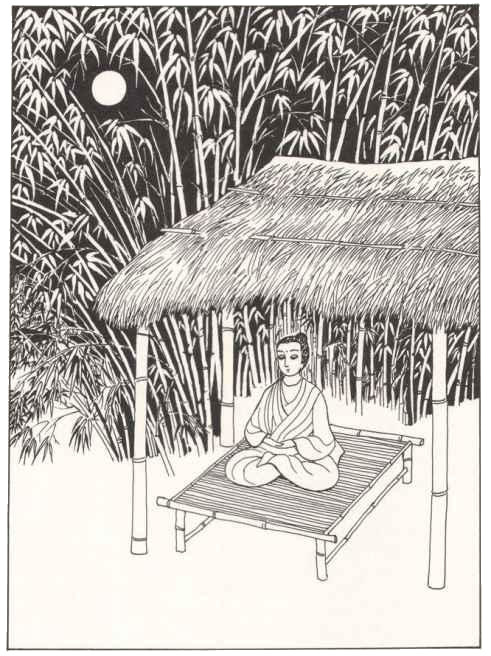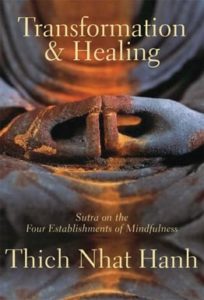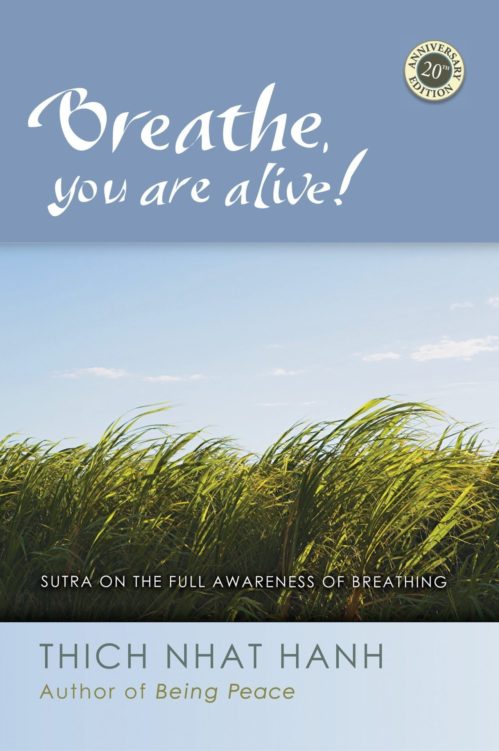
I heard these words of the Buddha one time when he was living at Kammassadhamma, a market town of the Kuru people. The Buddha addressed the bhikkhus, “O bhikkhus.”
And the bhikkhus replied, “Venerable Lord.”
The Buddha said, “Bhikkhus, there is a most wonderful way to help living beings realize purification, overcome directly grief and sorrow, end pain and anxiety, travel the right path, and realize nirvana. This way is the Four Establishments of Mindfulness.
“What are the Four Establishments?
- “Bhikkhus, a practitioner remains established in the observation of the body in the body, diligent, with clear understanding, mindful, having abandoned every craving and every distaste for this life.
- “He remains established in the observation of the feelings in the feelings, diligent, with clear understanding, mindful, having abandoned every craving and every distaste for this life.
- “He remains established in the observation of the mind in the mind, diligent, with clear understanding, mindful, having abandoned every craving and every distaste for this life.
- “He remains established in the observation of the objects of mind in the objects of mind, diligent, with clear understanding, mindful, having abandoned every craving and every distaste for this life.
1. Body
“And how does a practitioner remain established in the observation of the body in the body?
“She goes to the forest, to the foot of a tree, or to an empty room, sits down cross-legged in the lotus position, holds her body straight, and establishes mindfulness in front of her.
She breathes in, aware that she is breathing in.
She breathes out, aware that she is breathing out.
When she breathes in a long breath, she knows,
‘I am breathing in a long breath.’
When she breathes out a long breath, she knows,
‘I am breathing out a long breath.’
When she breathes in a short breath, she knows,
‘I am breathing in a short breath.’
When she breathes out a short breath, she knows,
‘I am breathing out a short breath.’
“She uses the following practice:
‘Breathing in, I am aware of my whole body.
Breathing out, I am aware of my whole body.
Breathing in, I calm my body.
Breathing out, I calm my body.’
“Just as a skilled potter knows
when he makes a long turn on the wheel,
‘I am making a long turn,’
and knows when he makes a short turn,
‘I am making a short turn,’
so a practitioner, when she breathes in a long breath, knows,
‘I am breathing in a long breath,’
and when she breathes in a short breath, knows,
‘I am breathing in a short breath,’
when she breathes out a long breath, knows,
‘I am breathing out a long breath,’
and when she breathes out a short breath, knows,
‘I am breathing out a short breath.’
“She uses the following practice:
‘Breathing in, I am aware of my whole body.
Breathing out, I am aware of my whole body.
Breathing in, I calm my body.
Breathing out, I calm my body.’
“Moreover,
when a practitioner walks, he is aware, ‘I am walking.’
When he is standing, he is aware, ‘I am standing.’
When he is sitting, he is aware, ‘I am sitting.’
When he is lying down, he is aware, ‘I am lying down.’
In whatever position his body happens to be, he is aware of the position of his body.
“Moreover, when the practitioner is going forward or backward, he applies full awareness to his going forward or backward. When he looks in front or looks behind, bends down or stands up, he also applies full awareness to what he is doing. He applies full awareness to wearing the sanghati robe or carrying the alms bowl. When he eats or drinks, chews, or savors the food, he applies full awareness to all this. When passing excrement or urinating, he applies full awareness to this. When he walks, stands, lies down, sits, sleeps or wakes up, speaks or is silent, he shines his awareness on all this.
“Further, the practitioner meditates on her very own body from the soles of the feet upwards and then from the hair on top of the head downwards, a body contained inside the skin and full of all the impurities which belong to the body: ‘Here is the hair of the head, the hairs on the body, the nails, teeth, skin, flesh, sinews, bones, bone marrow, kidneys, heart, liver, diaphragm, spleen, lungs, intestines, bowels, excrement, bile, phlegm, pus, blood, sweat, fat, tears, grease, saliva, mucus, synovial fluid, urine.’
“Bhikkhus, imagine a sack which can be opened at both ends, containing a variety of grains – brown rice, wild rice, mung beans, kidney beans, sesame, white rice. When someone with good eyesight opens the bags, he will review it like this: ‘This is brown rice, this is wild rice, these are mung beans, these are kidney beans, these are sesame seeds, this is white rice.’ Just so the practitioner passes in review the whole of his body from the soles of the feet to the hair on the top of the head, a body enclosed in a layer of skin and full of all the impurities which belong to the body: ‘Here is the hair of the head, the hairs on the body, nails, teeth, skin, flesh, sinews, bones, bone marrow, kidneys, heart, liver, diaphragm, spleen, lungs, intestines, bowels, excrement, bile, phlegm, pus, blood, sweat, fat, tears, grease, saliva, mucus, synovial fluid, urine.’
“Further, in whichever position her body happens to be, the practitioner passes in review the elements which constitute the body: ‘In this body is the earth element, the water element, the fire element, and the air element.’
“As a skilled butcher or an apprentice butcher, having killed a cow, might sit at the crossroads to divide the cow into many parts, the practitioner passes in review the elements which comprise her very own body: ‘Here in this body are the earth element, the water element, the fire element, and the air element.’
Further, the practitioner compares his own body with a corpse which he visualizes thrown onto a charnel ground and lying there for one, two, or three days – bloated, blue in color, and festering, and he observes, ‘This body of mine is of the same nature. It will end up in the same way; there is no way it can avoid that state.’
- “Further, the practitioner compares his own body with a corpse which he visualizes thrown onto a charnel ground; pecked at by crows, eaten by hawks, vultures, and jackals, and infested with maggots and worms, and he observes, ‘This body of mine is of the same nature, it will end up in the same way, there is no way it can avoid that state.’
- “Further, the practitioner compares his own body with a corpse which he visualizes thrown onto a charnel ground; it is just a skeleton with a little flesh and blood sticking to it, and the bones are held together by the ligaments.
- “Further, the practitioner compares his own body with a corpse which he visualizes thrown onto a charnel ground; it is just a skeleton, no longer adhered to by any flesh, but still smeared by a little blood, the bones still held together by the ligaments.
- “Further, the practitioner compares his own body with a corpse which he visualizes thrown onto a charnel ground; it is just a skeleton, no longer adhered to by any flesh nor smeared by any blood, but the bones are still held together by the ligaments.
- “Further, the practitioner compares his own body with a corpse which he visualizes thrown onto a charnel ground; all that is left is a collection of bones scattered here and there; in one place a hand bone, in another a shin bone, a thigh bone, a pelvis, a spinal column, a skull.
- “Further, the practitioner compares his own body with a corpse which he visualizes thrown onto a charnel ground; all that is left is a collection of bleached bones, the color of shells.
- “Further, the practitioner compares his own body with a corpse which he visualizes thrown onto a charnel ground; it has been lying there for more than one year and all that is left is a collection of dried bones.
- “Further, the practitioner compares his own body with a corpse which he visualizes thrown onto a charnel ground; all that is left is the dust which comes from the rotted bones, and he observes, ‘This body of mine is of the same nature, it will end up in the same way. There is no way it can avoid that state.’
“This is how the practitioner remains established in the observation of the body in the body, observation of the body from within or from without, or both from within or from without. He remains established in the observation of the process of coming-to-be in the body or the process of dissolution in the body or both in the process of coming-to-be and the process of dissolution. Or he is mindful of the fact, ‘There is a body here,’ until understanding and full awareness come about. He remains established in the observation, free, not caught in any worldly consideration. That is how to practice observation of the body in the body, O bhikkhus.”
2. Feelings
“Bhikkhus, how does a practitioner remain established in the observation of the feelings in the feelings?
“Whenever the practitioner has a pleasant feeling, she is aware, ‘I am experiencing a pleasant feeling.’ The practitioner practices like this for all the feelings, whether they are pleasant, painful, or neutral, observing when they belong to the body and when they belong to the mind.
“This is how the practitioner remains established in the observation of the feelings in the feelings, observation of the feelings from within or from without, or observation of the feelings both from within and from without. She remains established in the observation of the process of coming-to-be in the feelings or the process of dissolution in the feelings or both in the process of coming-to-be and the process of dissolution. Or she is mindful of the fact, ‘There is feeling here,’ until understanding and full awareness come about. She remains established in the observation, free, not caught in any worldly consideration. That is how to practice observation of the feelings in the feelings, O bhikkhus.”
3. Mind (Mental Formations)
“Bhikkhus, how does a practitioner remain established in the observation of the mind in the mind?
“When his mind is desiring, the practitioner is aware, ‘My mind is desiring.’ When his mind is not desiring, he is aware, ‘My mind is not desiring.’ He is aware in the same way concerning a hating mind, a confused mind, a collected mind, a dispersed mind, an expansive mind, a narrow mind, the highest mind, and a concentrated and liberated mind.
This is how the practitioner remains established in the observation of the mind in the mind, observation of the mind from within or from without, or observation of the mind both from within and from without. He remains established in the observation of the process of coming-to-be in the mind or the process of dissolution in the mind or both in the process of coming-to-be and the process of dissolution. Or he is mindful of the fact, ‘There is mind here,’ until understanding and full awareness come about. He remains established in the observation, free, not caught in any worldly consideration. This is how to practice observation of the mind in the mind, O bhikkhus.”
4. Objects of Mind
“Bhikkhus, how does a practitioner remain established in the observation of the objects of mind in the objects of mind?
“First of all, she observes the objects of mind in the objects of mind with regard to the Five Hindrances. How does she observe this?
- “When sensual desire is present in her, she is aware,
‘Sensual desire is present in me.’ - Or when sensual desire is not present in her, she is aware,
‘Sensual desire is not present in me.’ - When sensual desire begins to arise, she is aware of it.
- When sensual desire that has already arisen is abandoned, she is aware of it.
- When sensual desire that has already been abandoned will not arise again in the future, she is aware of it.
“She practices in the same way concerning anger, dullness and drowsiness, agitation and remorse, and doubt.
“Further, the practitioner observes the objects of mind in the objects of mind with regard to the Five Aggregates of Clinging. How does she observe this? She observes like this:
- ‘Such is form. Such is the arising of form. Such is the disappearance of form.’
- ‘Such is feeling. Such is the arising of feeling. Such is the disappearance of feeling.’
- ‘Such is perception. Such is the arising of perception. Such is the disappearance of perception.’
- ‘Such are mental formations. Such is the arising of mental formations. Such is the disappearance of mental formations.’
- ‘Such is consciousness. Such is the arising of consciousness. Such is the disappearance of consciousness.’
“Further, bhikkhus, the practitioner observes the objects of mind in the objects of mind with regard to the six sense organs and the six sense objects. How does she observe this?
“She is aware of the eyes and aware of the form, and she is aware of the internal formations which are produced in dependence on these two things. She is aware of the birth of a new internal formation and is aware of abandoning an already produced internal formation, and she is aware when an already abandoned internal formation will not arise again.
“She is aware in the same way of the ears and sound, the nose and smell, the tongue and taste, the body and touch, the mind and objects of mind.
“Further, bhikkhus, the practitioner remains established in the observation of the objects of mind in the objects of mind with regard to the Seven Factors of Awakening.
“How does he remain established in the practice of observation of the Seven Factors of Awakening?
- “When the factor of awakening, mindfulness, is present in him, he is aware, ‘Mindfulness is present in me.’
- When mindfulness is not present in him, he is aware, ‘Mindfulness is not present in me.’
- He is aware when not-yet-born mindfulness is being born
- and when already-born mindfulness is perfectly developed.
“In the same way, he is aware of the factors of investigation, diligence, joy, ease, concentration, and equanimity.
“Further, bhikkhus, a practitioner remains established in the observation of objects of mind in the objects of mind with regard to the Four Noble Truths.
“How, bhikkhus, does the practitioner remain established in the observation of the Four Noble Truths?
“A practitioner is aware
- ‘This is suffering,’ as it arises.
- She is aware, ‘This is the cause of the suffering,’ as it arises.
- She is aware, ‘This is the end of suffering,’ as it arises.
- She is aware, ‘This is the path which leads to the end of suffering,’ as it arises.
“This is how the practitioner remains established in the observation of the objects of mind in the objects of mind either from within or from without, or both from within and from without. She remains established in the observation of the process of coming-to-be in any of the objects of mind or the process of dissolution in the objects of mind or both in the process of coming-to-be and the process of dissolution. Or she is mindful of the fact, ‘There is an object of mind here,’ until understanding and full awareness come about. She remains established in the observation, free, not caught in any worldly consideration. That is how to practice observation of the objects of mind in the objects of mind, O bhikkhus.”
“Bhikkhus, he who practices the Four Establishments of Mindfulness for seven years can expect one of two fruits – the highest understanding in this very life or, if there remains some residue of affliction, he can attain the fruit of no-return.
“Let alone seven years, bhikkhus, whoever practices the Four Establishments of Mindfulness for six, five, four, three, two years or one year, for seven, six, five, four, three, or two months, one month or half a month, can also expect one of two fruits – either the highest understanding in this very life or, if there remains some residue of affliction, he can attain the fruit of no-return.
“That is why we said that this path, the path of the four grounds for the establishment of mindfulness, is the most wonderful path, which helps beings realize purification, transcend grief and sorrow, destroy pain and anxiety, travel the right path, and realize nirvana.” The bhikkhus were delighted to hear the teaching of the Buddha. They took it to heart and began to put it into practice.
Translated by Thich Nhat Hanh from Satipaṭṭhāna Sutta, Majjhima Nikāya 10.




Share Your Reflections